Laptops are a particular nuisance because they’re miniaturized: all the parts are compact and jammed into a really tight space. Worse than that, some parts are made to fit only one specific machine. While the external keyboard for a desktop computer is an off-the-shelf component you can replace for a few dollars, the one on a laptop is generally made to fit only one machine (or one make of computer) and a replacement, carried out by a dealer, could cost you a quarter the price of a new machine!
But don’t worry, because some of the most common things that go wrong with laptops are surprisingly easy to fix all by yourself. If you’re reasonably competent (and confident), and your broken machine looks like it’s heading for the scrap heap anyway, why not investigate whether you can fix it yourself before you buy a new computer? Here are some simple tips based on my own experiences owning and repairing laptops over the last two decades or so.
1. Take a backup
“For most people, the biggest challenge is just overcoming nerves related to fixing. We’re told that we are not supposed to open, or even alter the products we own. But these attitudes are all relatively new!”
Janet Gunter, The Restart Project
If your machine is still working, be sure to back up the entire hard-drive (or at least your most important documents) before you start. Copy the whole of your “My documents” (or “Documents” on a Linux machine) onto a USB flash drive or burn it onto a CD-ROM. (If it’s not too big, you could even upload it to cloud storage.) If your computer won’t boot to let you back it up, you may be able to boot it from a CD-ROM or startup floppy (remember those?) and then copy files that way. (Another handy tip: if you’re familiar with Linux, you might be able to boot using a Linux live CD, mount the Windows partition, and then copy the files onto an external flash drive inside Linux.) If you’re pretty sure the hard drive is intact, you may want to remove that and put it somewhere safe before you try other repairs. You’ll generally be able to read the hard drive from one machine in another, though you probably won’t be able to boot up from it in a different machine.
One thing to note in passing is that making backups only when your computer has just crashed is a bit silly. Get into the habit of making backups regularly. Corporate IT departments usually back up their systems every night. Since I work from home, I make sure I back up the documents folder on my hard drive once a week without fail: it takes about a minute to copy the whole thing onto a USB memory stick, overwriting one of the backups from previous weeks. Try to organize your computer so the regularly changed items are in one place and quicker to copy. Backup less frequently changed things (maybe your photo or music collection) less often. Remember you can use things like MP3 players to store computer files as well as music, so you can use those as handy portable backups if you need to. Another good tip is to keep an offsite backup somewhere. Keep a copy of your home computer’s documents folder on a USB drive in your desk at work, for example. Then you’re better protected against things like fire and theft. There are also plenty of secure, inexpensive cloud-based storage systems (such as Amazon’s S3, Google Drive, and Apple iCloud) that you can use to backup your files online.
2. Work around with a plugin
Virtually every modern laptop has several USB sockets and it’s easy to plug in an external keyboard, mouse, screen, webcam, hard drive, and so on. Most older laptops also have a PCMCIA card socket (a thin slot on one side) where you can plug in an external modem, Wi-Fi card, or USB hub. If something obvious breaks on your laptop, the simplest, cheapest, and easiest “repair” you can make is often to switch to an external device. So, for example, if your keyboard breaks, you can use a plugin USB keyboard. (If your USB has broken as well, switch to Bluetooth.) If your sound card packs up, get yourself something like a Griffin iMic (a little external sound card that plugs into your USB port). If the modem stops working, and you have a PCMCIA port, try a plugin modem card. If one of your USB sockets stops working, get a plugin USB hub and use that in one of the other USB sockets instead; if all your USB sockets fail, get a PCMCIA USB hub. You can usually buy these sorts of addon “peripherals” for a few dollars on eBay and you can fit them in seconds, yourself, without tinkering inside your computer or worrying about making things worse. Job done!
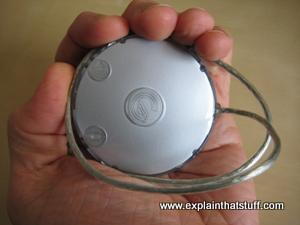
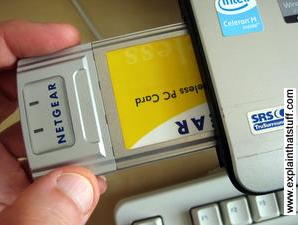
Photo: 1) On older machines, plugin PCMCIA cards offer a good, simple solution to some of the most common laptop failures. This is a plugin wireless card; you can also get plugin USB cards, dialup modems, memory cards, and lots more. 2) Unfortunately, you won’t find a PCMCIA slot on newer laptops; you’ll need to use USB instead. The second photo shows a Griffin iMic external USB sound card.
3. Know your “service flaps”
Understandably enough, most laptop users spend all their time looking at the keyboard and the screen. But if you spend a moment looking at the underside of your machine, you’ll find there are maybe half-a-dozen little plastic flaps, secured with one or two screw or slide clips, giving access to the components most likely to go wrong and need replacing. Generally, you can remove the battery, the hard drive, and add extra memory, and you may also be able to replace the CPU fan—all without going into the innards of the machine.
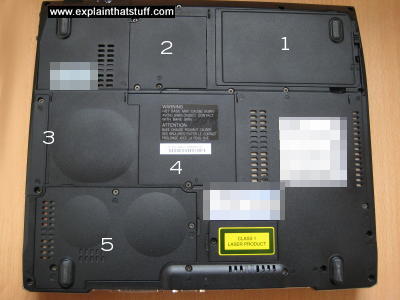
Photo: This laptop has five small flaps underneath giving easy access to the main components by lifting only a couple of screws. It varies from machine to machine, but on this one: 1 is the battery; 2 is the LAN card; 3 is the hard drive; 4 is for memory expansion; 5 is the CPU fan and CPU. Unscrewing flap 4, for example, reveals the memory expansion slots, shown below. The two cards simply click in and out, so it’s easy to add extra memory to speed up your machine.
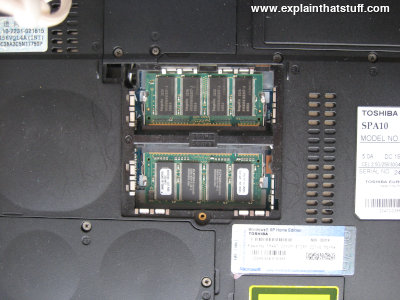
The components that live under these flaps simply plug into slots (in the case of memory expansion cards) or ribbon connectors, as shown in the photo further down this page. You won’t need to do any soldering, or anything of that kind, but you will need to be slow, careful, and patient to avoid bending the connecting pins. In the photo below, I’m replacing one of the memory cards with a bigger one. After pressing aside two retaining clips, it’s just a matter of carefully pulling out one card and pushing in the replacement.
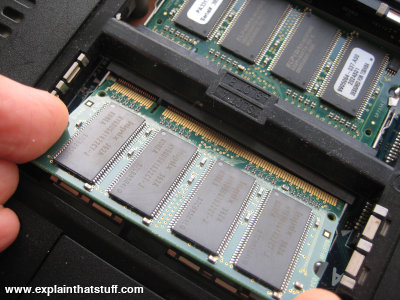
A few years ago, when I crashed the hard-drive on my nearly new laptop, I took it into a dealer for a very expensive repair, which would have involved unplugging the broken drive and swapping it for a completely new one and probably took about a minute. Shortly afterward, I discovered I could have done the same job myself by removing a couple of screws on the base of my machine. It would have been easy to look up the part number on Google or eBay and order myself a new drive at a fraction the price I was charged.
Take a few moments to look through the manual that came with your machine. Find out what flaps it has underneath and what you can easily gain access to and repair.
Digging deeper
Some parts of your machine won’t be accessible through service flaps—and it’s usually far from obvious how to get deeper into a laptop if the bit you want to replace isn’t in sight. Once you start removing the main case screws, everything gets more tricky: if you take the wrong screws out, you can quickly find the machine falling apart in your hands! Some laptops have snap-off plastic covers (quite common with the screen surround, which you can usually snap off after removing a couple of screws hidden under circular plastic covers at the top and bottom). Others have snap-off covers over the power switches and around the keyboards. If you look closely, you can often see little recesses where a screwdriver can be inserted. But if you get it wrong and push or pull in the wrong place, you’ll snap the plastic and damage it horribly.
Before you start wrecking your machine, search for online videos or repair sites that show you exactly how to get inside and access the part you want to replace. Bear in mind that some manufacturers (Apple in particular) go to very great lengths to prevent you repairing their devices, obliging you to buy new ones, and some devices are just difficult or impossible to repair. Sony ebook readers, for example, have extremely fragile screens that are bordering on impossible to remove; even their batteries are firmly glued inside and difficult to replace. Nevertheless, you might still find a handy video on YouTube explaining how to do exactly the repair you need (always check first to see if someone has blazed a trail you can follow!)—and that can make all the difference. If your gadget is completely broken, you’ve nothing (but time) to lose by having a go—and you may well find it a very educational experience, even if you end up with a load of broken junk that’s entirely beyond repair (I got a fascinating insight into how touchscreens work by taking my ebook reader apart, for example, though all I had to show for my “repair” was a pile of broken glass, metal, and plastic).
4. Search your symptoms
If your computer’s problem isn’t obvious, try looking up the symptoms on your favorite search engine. That’s how I discovered the LCD screen inverter needed replacing on one of my old laptops: the screen was flickering and occasionally going dark, but I could still see what was written on it very clearly. Having learned about the risks of replacing an inverter (it’s a high-voltage component), I took appropriate precautions, then removed a couple of screws on the bottom of my laptop’s screen and ventured inside. It was easy and cheap to order a new part from eBay and I fitted a replacement in about thirty seconds. I was amazed and delighted that I’d turned a useless machine, destined for the garbage dump, into something as good as new with virtually zero effort. And the repaired machine is still working well over 10 years later.
5. Find your spare part
Once you know what’s wrong with your computer, you’ll generally need to replace one or more parts. Locating the right part is half the battle when you’re making repairs. Assuming you can get at them, fitting spares is often much easier than it sounds. The parts most likely to go wrong are the ones under the little flaps on the base of your machine. Simply read off the part number and type it into Google and eBay and see what you find. Often, you’ll find an official replacement from the manufacturer and maybe cheaper equivalents made by other companies. You’ll find secondhand bits recovered from broken laptops on eBay. There are also lots of broken laptops for sale on eBay and it may be cheaper to buy a “spares and repair” version of your exact machine and salvage appropriate parts than to worry about finding one specific part. Then you’ll have other spare bits ready for future failures as well.
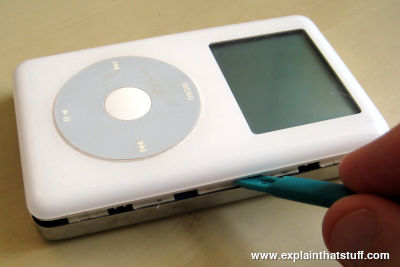
Photo: Some manufacturers make it deliberately difficult to open up their devices for repair because they want you to buy yet another new one. Even so, a bit of online research is usually all you need to get inside. With the right plastic tool, opening up an iPod Classic is relatively simple and does no damage at all.
6. Take care when fitting spares
The main parts of a laptop are usually modular and designed to be replaced. Things like a laptop keyboard, for example, simply plug into the motherboard (the main circuit board) with a little clip you can remove yourself; they’re not soldered in place. That doesn’t mean computer parts are robust: often they’re easily damaged and can’t withstand hamfisted repairs. Even if you handle them carefully, some parts (memory chips, for example) are susceptible to damage from static electricity. Google around before you fit a new part and read up on any special precautions you need to take. Don’t be in a rush; your computer’s not going anywhere.
Broken “mechanical” parts of your laptop are a bit harder to replace and do require a bit of dexterity and technical skill. For example, laptops that are opened and closed repeatedly will eventually suffer from broken hinges. Replacing parts like that can be tricky: often you’ll need to remove quite a lot of screws and other decorative parts and there is a bit of scope for damaging your machine in the process. Go slowly, be patient, and take close-up photos at each stage so you know exactly where everything went; that makes it easy to put it all back again later.
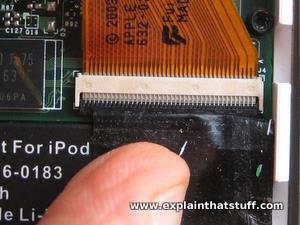
Photo: This iPod circuit board uses flexible flat ribbon cables to link together its various modular components. The connections are easy to remove, but you typically need to lift a flap before you can do it or you’ll snap them. Learn how to open and close one properly before you make a start!
7. How will it fail?
Although manufacturers probably don’t design their machines to wear out (computers make themselves obsolete after a few years whether you use them or not), laptops certainly don’t seem as well built as they were about a decade ago. Failures are more likely now computers are being used by a wider, less experienced group of people. It’s worth anticipating when and how your new machine is likely to go wrong—and taking a bit more care to stop that happening.
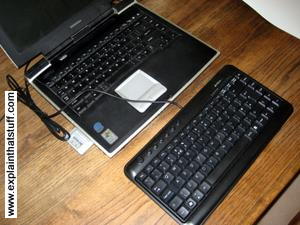
Photo: Laptop keyboards will not withstand years of constant pounding. Why not assume your keyboard is going to break and use an external keyboard from the start?
For example, I am a writer and I pound my laptop for many hours each day. It came as no big surprise when I wore out the keyboard on my first laptop after only a couple of years, even though I’d owned typewriters that were decades old. I had my laptop professionally repaired, at great expense, and then did exactly the same thing again a couple of years later. This time I got the message: laptop keyboards are very flimsy compared to desktop ones and they’re not designed for industrial-strength work. So, the next time I bought a laptop, I bought a cheap, external keyboard (which is far nicer to type on) and now I sit my laptop on a stand and pound the external keyboard instead, while my laptop’s own keyboard sits there mostly unused. If I wear out the keyboard now, it’s about five dollars for a replacement. (You can use an external mouse and screen in much the same way. Once your laptop is sitting on a desk all day plugged into peripherals, you might ask yourself why you didn’t buy a desktop machine to begin with; they’re generally far easier to upgrade and repair.)
If you look through the broken machines for sale on eBay, you’ll find a few other common causes of laptop mortality. Liquid damage is high up the list. Spill a cup of coffee on a laptop and you can be reasonably confident it won’t work again, so get into the habit of drinking away from the machine. Broken USB sockets are also reasonably common, usually caused by people trying to force plugs in the wrong way around. USB connectors are inherently robust—they’re meant to be “plug and play”—but that doesn’t mean they’re indestructible. Bear in mind that the sockets you plug your peripherals into are soldered (sometimes not that well) directly onto a circuit board in your machine and if you press them too hard, too often, you can break the connections. So treat your laptop with a bit of care and respect and it’ll repay you with years of faithful service. I have a Toshiba dating from 1996 that stills works fine; I’d still be using the ENIAC if it would only run Firefox.
8. Maybe someone else can help?
Some of the things I’ve suggested above are low-risk or no-risk: using a workaround USB device, for example. But if you really can’t avoid a physical repair and you’re not confident enough to attempt it yourself, does that mean you have to trash your laptop and buy a new one? Not necessarily! Check out things like “repair cafes” where experienced volunteers get together to help one another with fixes. There are some links in the “Find out more” section below.
9. What can you do with a really old machine?
You could be forgiven for thinking there’s a conspiracy between people who make operating systems (Microsoft, in other words) and those who make laptops. One of the biggest reasons people have for ditching old computers is that they can no longer run the latest version of Microsoft Windows. A lot of decent computers get junked when each version of Windows reaches its “end of life” date, even though they’re still perfectly serviceable. One way you can escape this problem is to switch to the Linux operating system, which will generally run on much less powerful (read: older) machines. I have two fairly old laptops running up-to-date versions of Linux quite happily even though they were built for Windows XP about two decades ago and one of them has just 512MB of RAM.
Problem solved? Not exactly. One issue you’ll now come up against with old machines (by which I mean 10–20 years old) is that they’ll probably have what’s called a 32-bit architecture, whereas most modern operating systems assume a 64-bit architecture instead. Versions of Windows up to Windows 10 will still generally run on 32-bit machines, as will most versions of Linux (technically known as distributions or “distros”) produced before about 2020. But it’s getting harder to find even Linux distros that will run on 32-bit machines. (For example, Lubuntu, once “sold” as a low-resource Ubuntu distro, perfect for saving older machines, has now joined the 64-bit club.) There are still a few 32-bit distros, but using them will involve a little bit of compromise: the Chromium web browser, for example, is now 64-bit only, so if you’re going to use a 32-bit Linux distro, you’ll need to browse with Firefox (or some other browser).
Still, if you’re determined to save an old machine and you enjoy a little bit of geekery, installing a 32-bit Linux distro (such as Debian, Puppy, Sparky, antiX, and a few others) is probably the way to go.







